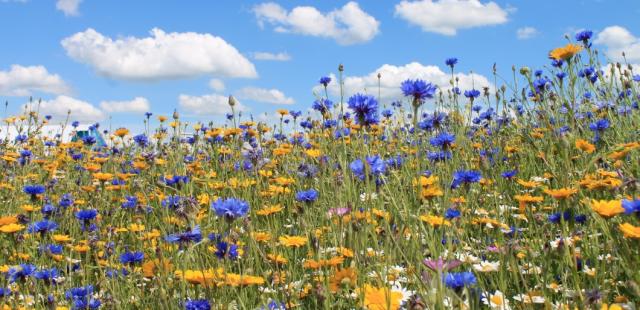
DLF Wildflowers
Wildflower mixtures suitable for Amenity landscaping and habitat recreation
Wildflower Species
Our exciting range of wildflower mixtures have been designed to create attractive amenity spaces that act as an essential food source for a range of animals and invertebrates, especially pollinating insects. These versatile mixtures are ideal for bare patches around the farmyard, on banks along roadways and ditches or as a colourful buffer strip along streams or drains.
Carnival
• With 17 flower species, this mix is designed to create a robust and attractive display in any park, public open space or golf course
• This 100% flower mixture will provide a dazzling annual display that is quick to establish
• Carnival has a long flowering period from 8 weeks after sowing up until the first frosts Sowing Rate 3 - 5g/m 2 Available in 500g packs = 100m 2
Floral Carpet
• Low-Growing seasonal annuals mixture designed to create a robust and attractive display in areas where final growing height is paramount
• This is particularly relevant when sowing near visibility splays and sight lines on road junctions and roundabouts
• This 100% dwarf flower mixture will provide rich blooms throughout the season, perfect for enhancing any street scene Sowing Rate 3 - 5g/m 2 Available in 500g packs = 100m 2
Biodiversity
• Seasonal Perennials mixture containing 100% Flowers, this mixture consists of 90% perennial flower species and 10% annual species that give colour the first year
• The composition of species is wide and ensures good adaptability to different growing conditions
• The colour scheme of the mix changes during the season Sowing Rate 3 - 5g/m 2 Available in 500g packs = 100m 2
Suitable for Agriculture and Amenity
Butterfly & Bee Meadow Mix
AB8 Native Perennial Wildflowers with Grass
• A wildflower meadow mix with flowers to attract important pollinating insects, including
many kinds of butterflies and bees
• The grasses provide a habitat for pollinators and help ensure that weeds don’t out compete
the flowers
• 50% Flowering species 50% fine non-aggressive grasses. Ideal for banks/waste ground
Sowing Rate 1.6g/m 2 Available in 1kg packs = 600m 2
Site Preparation
The aim is to produce a firm, weed-free stale seedbed. Subsoils often provide a weed-free,
low-nutrient status seed bed and are suitable for wild flora. However, it is occasionally
necessary to remove the topsoil in areas of high fertility, as these soils tend to promote the growth of more vigorous grasses and pernicious weeds. Treat existing vegetation with a
systemic herbicide before seedbed cultivation, taking note of any site constraints and
manufacturer’s instructions first.
Sowing annuals & perennials
Sowing can take place throughout most of the year, providing a good stale seedbed can be
prepared. However, the months of March/April and August/ September are generally the
most suitable.
1 Regularly mix seed to ensure even species distribution, drill or broadcast
2 Bulk up small seeding rates with sand or porridge oats, four parts to one part seed
3 Rake or harrow - mix the seed into the soil (depth approx. 0.5cm), roll to firm seedbed
Wildflower Maintenace
Annuals complete their life cycle in one year, i.e. they will germinate, grow, produce a flower, set seed and die all in one year. Therefore, you will see them flower the summer after sowing if sown in Autumn and 8 weeks after sowing if sown in Spring. Perennials come back year after year, however, they will not flower until the second year after sowing.
First year management of perennial wildflowers
In the first year, control the weeds and reduce competition from grasses. Cut the sward to a
height of 5-7cm every two months or when the sward reaches 15cm. Remove all the cuttings. Dig out or spot-treat any perennial weeds.
Future maintenance of perennial wildflowers
Cut to 5-7cm during March/April and remove cuttings. A second cut should take place at the end of the flowering season during August/October. Remove all cuttings. Further cuts in the autumn period to remove untidy growth may be required.
Learn More About Wildflowers
Want to know more? Reach out to your local DLF representative today or leave us a message using our chat widget!